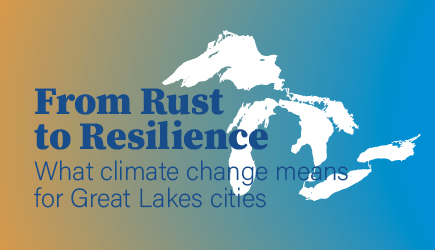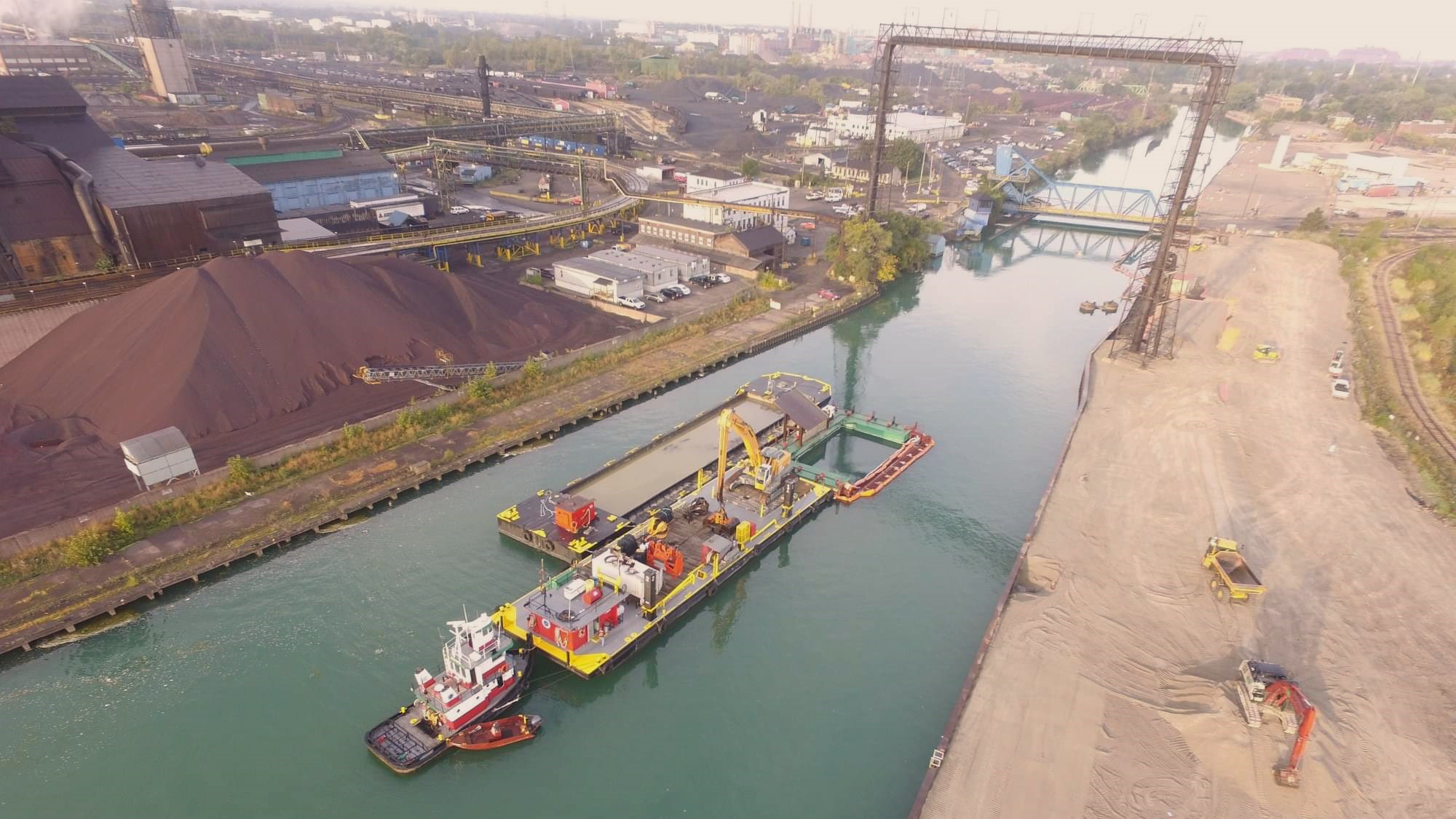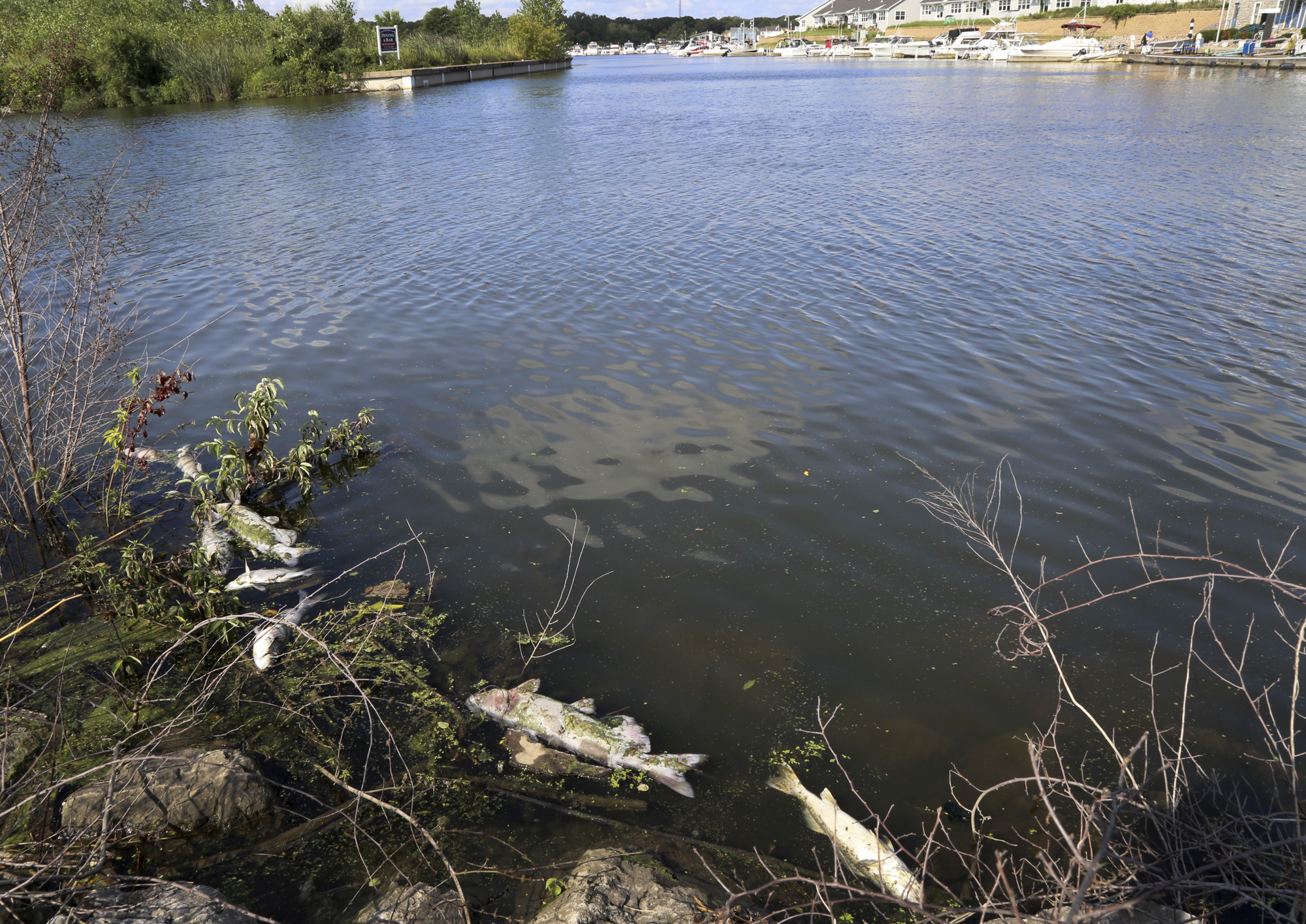
By Dave Rosenthal

This article is part of the Pulitzer Center’s nationwide Connected Coastlines reporting initiative. For more information, go to pulitzercenter.org/connected-coastlines-initiative.
For all stories in the “From Rust to Resilience” project, including the Great Lakes Now monthly show, click HERE.
The video shot in the summer of 2016 is grisly.
In it, Mark Mattson, co-founder of the Lake Ontario Waterkeeper, displays materials skimmed from the Toronto harbor, which lies along the northwestern end of Lake Ontario.
As his small boat bobs in the water, he lays them on a wooden oar: slimy condoms, tampons and wet naps.
And he points to a likely culprit: the millions of gallons of raw sewage that are dumped into the harbor and Lake Ontario after big rainstorms.

Water is collected as part of the Lake Ontario Waterkeeper’s sampling process in Toronto’s harbor. Photo courtesy of Lake Ontario Waterkeeper.
The problem results from the way infrastructure in Toronto — and hundreds of other cities along the Great Lakes — was built decades ago. In older cities, a single system of pipes may transport sewage as well as stormwater runoff.
That system is sufficient on most days. Treatment plants can remove contaminants before discharging the water into the harbor or its tributaries.
But a big storm can overwhelm a treatment plant’s capacity. When that happens, water rushing through those pipes bypasses the plant and ends up, untreated, in the lake.
It’s unsightly — and unhealthy. The sewage can contaminate beaches with e coli bacteria. Unless the beaches close, swimmers can get infections and other health problems.
Watch this Great Lakes Now‘s segment on the city of Buffalo, its sewer department and green infrastructure:
API key not valid. Please pass a valid API key.Not Just Toronto
That’s been an issue for years, and now climate change has brought a new urgency for cities like Toronto to take action.
Climate change is expected to bring more intense storms to the Great Lakes region. That means more raw sewage flowing into the lakes, and a greater likelihood that beaches will be closed due to bacterial contamination.

Krystyn Tully is co-founder and vice president of the Lake Ontario Waterkeeper, which is based in Toronto. Photo courtesy of Lake Ontario Waterkeeper.
“Extreme weather events are increasing in Toronto. That’s not a controversial point,” said Krystyn Tully, co-founder and vice president of the Lake Ontario Waterkeeper environmental group.
She sees a vicious cycle triggered by climate change: As the number of hot days increases, Toronto residents will want to go into the lake to cool off, especially low-income families. At same time, the lake’s water is getting warmer, and more frequent storms are leading to increased pollution.
“It’s a perfect storm, no pun intended,” she said. “We want the water to be clean … so people aren’t worried about the health impact.”
How bad is the problem across the Great Lakes region?
In just one year, 20 cities released 92 billion gallons of untreated sewage, mostly via sewage overflows, according to a report from the International Joint Commission, a U.S.-Canada group that helps to regulate the lakes.

Find this International Joint Commission online at: https://legacyfiles.ijc.org/tinymce/uploaded/GLWQA/TAP.pdf
That’s enough untreated sewage to fill nearly 150,000 Olympic-sized swimming pools.
It’s clearly a widespread problem — and one of the biggest sources of pollution in the Great Lakes region. Nearly 300 cities in the region have these antiquated sewer systems, the report notes. That includes Milwaukee, Cleveland, Chicago, Buffalo and Gary.
“In public meetings hosted by the IJC, the residents of Great Lakes communities voiced concern that extreme rainfall events are becoming more frequent, resulting in major discharges of untreated sewage,” says IJC spokesman Frank Bevacqua.
That’s a special challenge for Toronto, whose metro region population has increased from about 3 million in 1980 to more than 6.3 million today.
“The growth is crazy,” Tully says. “We don’t have infrastructure in place to deal with it.”
That’s changing. Toronto and other cities are addressing the sewage overflow problem in several ways. For example, they’re decoupling sewer lines and pipes that carry stormwater; in Toronto the combined systems are mainly in the oldest neighborhoods.
They’re also creating sections of “green infrastructure” — planted areas that will help slow and absorb stormwater runoff.
A 2017 Toronto report lays out technical guidelines for options such as planters, large swales and rain gardens. These methods can reduce runoff and take pressure off the city’s stormwater drainage system, the report says.
But it adds a note of caution. The initiatives “will not contribute significantly to mitigating the impacts of extreme precipitation events. … [This is] one of many strategies that must be employed in order for the City to adapt to climate change and to build a more resilient Toronto for the future.”
The most dramatic changes are happening underground.
In December, the city marked the start of a $3 billion project that will include a series of tunnels, storage tanks and other improvements to hold overflow stormwater and sewage until treatment plants can handle it. The city also is building a new high-capacity treatment plant.
At the kickoff event, Mayor John Tory said that previous administrations had planned to virtually eliminate sewage dumped into Lake Ontario by 2038. Tory added that his goal is to do it within 10 years, according to a Canadian Broadcasting Corp. report.
“It is a core responsibility that we have for our generation … but also for the next generation to stop dumping raw sewage into Lake Ontario and into the waterways that flow into it,” he said.
And the mayor drew a direct connection to the intense storms triggered by climate change. “We now know that in a post-climate change world, these storms unfortunately are a part of life that is going to happen for some time to come, and we just can’t allow the status quo to prevail.”
Developing the Vision
Meanwhile, the Lake Ontario Waterkeeper is continuing to help.
Using a federal grant, it is taking samples in a number of waterways to determine if e coli bacteria — a public health hazard — is present.
Toronto’s harbor along Lake Ontario will remain the largest monitoring hub, with five locations active from May to September. A core group of about 40 volunteers leads those sampling efforts.

Members of Lake Ontario Waterkeeper, a Toronto-based environmental group, sample in the city’s harbor. Photo courtesy of Lake Ontario Waterkeeper.
The organization has purchased its own lab equipment to speed up analysis. Now it’s looking for ways to get results quicker than the standard 18-24 hours — and to develop models that can predict where bacteria will appear.
Tully says all of these potential solutions will help Toronto residents answer a crucial question: “How do we develop a vision you would expect from a city of this size?”
Lauren Davis, Vivek Rao and Michael Skiles of Indiana University’s Arnolt Center for Investigative Reporting contributed research to this report.
Find out more in this behind-the-scenes interview with Dave Rosenthal:
API key not valid. Please pass a valid API key.“From Rust to Resilience: What climate change means for Great Lakes cities” is a collaborative reporting project that includes six members of the Institute for Nonprofit News (Belt Magazine, The Conversation, Ensia, Great Lakes Now at Detroit Public Television, MinnPost and Side Effects Public Media) as well as WUWM-FM Milwaukee, Indiana Public Broadcasting and The Water Main from American Public Media.
This project is part of the Pulitzer Center’s nationwide Connected Coastlines reporting initiative. For more information, go to pulitzercenter.org/connected-coastlines-initiative.

Read more from Great Lakes Now:



Featured image: Toronto sits on the northwestern edge of Lake Ontario. The harbor, formed by a small barrier island, is in the foreground. Photo courtesy of city of Toronto.
3 Comments
-
This is a periodic occurrence in Hamilton. Unfortunately, one incident has led to “Sewergate”. https://www.thespec.com/news/hamilton-region/2019/12/19/sewergate-for-dummies.html
-
Great work being done here. Climate change and the pathogenic dangers from sewage released into the water is seldom taught by main stream media to the general public. Once sewage containing pathogenic materials are released into the Great Lakes , mosquito spreading of pathogens is another risk. Once sewage is in the water the need to contain spreading should include vigilant monitoring of where ships can uptake ballast water. With contaminated ballast water uptakes the equipment for ballast water treatment is not as effective. Satellite imagery, even meteorologist, could be useful in communicating hot spots to shipping. Thank you for your work. Sincerely Don Mitchel
-
I loved reading your blog post on the resilience of sewer and wastewater infrastructure. It’s fascinating to learn about the challenges posed by rust and corrosion and how they impact the longevity and effectiveness of these systems. Your insights into the importance of regular maintenance and proactive measures to mitigate rust-related issues are invaluable. It’s inspiring to see efforts being made to address this issue and ensure the reliability of our sewer and wastewater systems. Thank you for sharing this important information!




